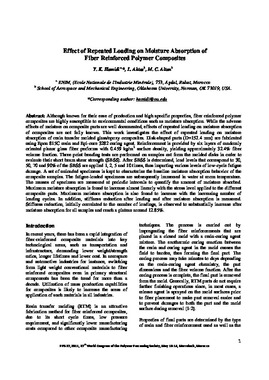| dc.contributor.author | Hamidi, Y. K. | |
| dc.contributor.author | Aktas, L. | |
| dc.contributor.author | Altan, M. C. | |
| dc.date.accessioned | 2016-03-23T20:11:47Z | |
| dc.date.accessioned | 2016-03-30T15:35:43Z | |
| dc.date.available | 2016-03-23T20:11:47Z | |
| dc.date.available | 2016-03-30T15:35:43Z | |
| dc.date.issued | 2011-05 | |
| dc.identifier.citation | Hamidi, Y. K., Aktas, L and Altan, M. C. , Presented at the 27th International Conference of the Polymer Processing Society. Article # 563, 2011. | en_US |
| dc.identifier.uri | https://hdl.handle.net/11244/33176 | |
| dc.description.abstract | Although known for their ease of production and high specific properties, fiber reinforced polymer composites are highly susceptible to environmental conditions such as moisture absorption. While the adverse effects of moisture on composite parts are well documented, effects of repeated loading on moisture absorption of composites are not fully known. This work investigates the effect of repeated loading on moisture absorption of resin transfer molded glass/epoxy composites. Disk-shaped parts (D=152.4 mm) are fabricated using Epon 815C resin and Epi-cure 3282 curing agent. Reinforcement is provided by six layers of randomly oriented planar glass fiber performs with 0.459 kg/m2 surface density, yielding approximately 32.4% fiber volume fraction. Three point bending tests are performed on samples cut from the molded disks in order to evaluate their short beam shear strength (SBSS). After SBSS is determined, load levels that correspond to 30, 50, 70 and 90% of the SBSS are applied 1, 2, 5 and 10 times, thus imparting various levels of low-cycle fatigue damage. A set of unloaded specimens is kept to characterize the baseline moisture absorption behavior of the composite samples. The fatigue-loaded specimens are subsequently immersed in water at room temperature. The masses of specimen are measured at periodic intervals to quantify the amount of moisture absorbed. Maximum moisture absorption is found to increase almost linearly with the stress level applied to the different composite parts. Maximum moisture absorption is also found to increase with the increasing number of loading cycles. In addition, stiffness reduction after loading and after moisture absorption is measured. Stiffness reduction, initially correlated to the number of loadings, is observed to substantially increase after moisture absorption for all samples and reach a plateau around 12.85%. | en_US |
| dc.language | en_US | en_US |
| dc.subject | Fiber Reinforced Polymer Composites | en_US |
| dc.subject | Moisture Absorption | en_US |
| dc.title | Effect of Repeated Loading on Moisture Absorption of Fiber Reinforced Polymer Composites | en_US |
| dc.type | Other | en_US |
| dc.description.peerreview | Yes | en_US |
| dc.description.peerreviewnotes | Peer reviewed and presented at the 27th International Conference of the Polymer Processing Society. | en_US |
| ou.group | College of Engineering::School of Aerospace and Mechanical Engineering | en_US |
